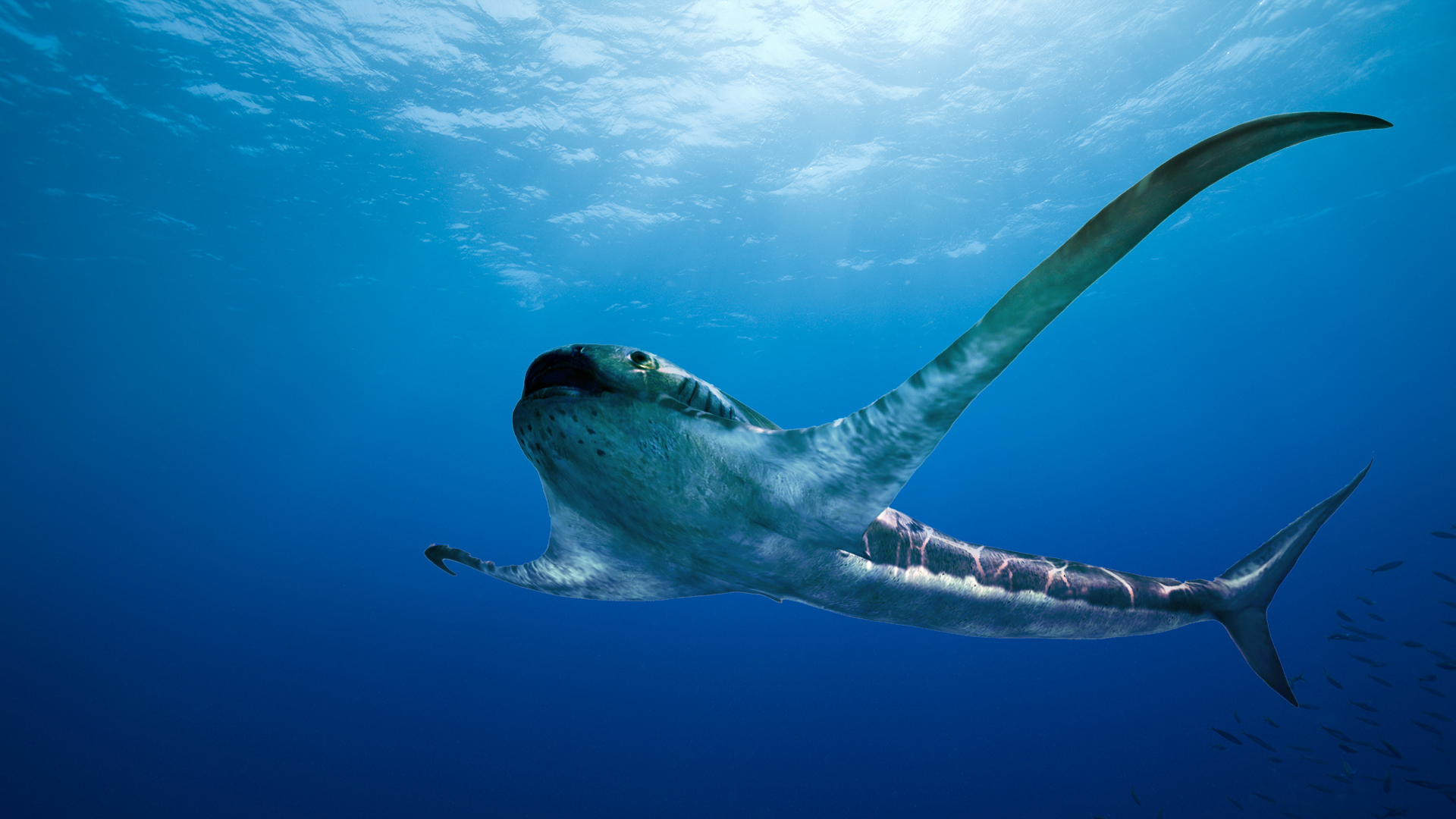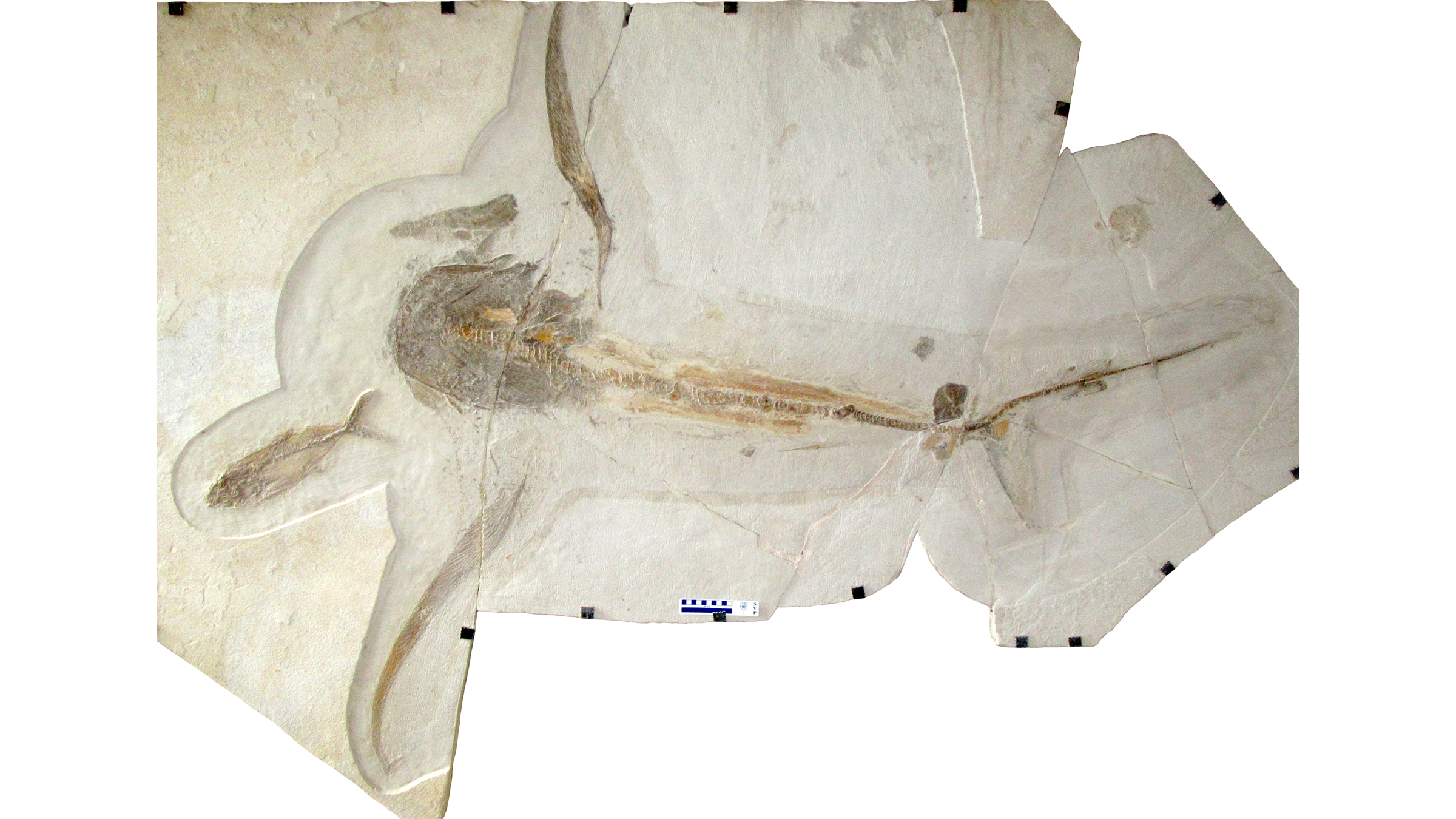'Winged' eagle shark soared through oceans 93 million years ago
It looked like a cross between a shark and a manta ray.

Update, April 16, 2021, at 10:09 a.m. EDT: In the study, the researchers wrote that the fossil of the Cretaceous-age shark Aquilolamna milarcae would be housed at the yet-to-be-built Milarca Museum in Nuevo León State, Mexico, but its construction was delayed due to the COVID-19 pandemic. Starting on May 1, the specimen will be housed at the Desert Museum in Saltillo, Mexico, "where it will be available to researchers for scientific purposes," according to an Erratum published April 16 in the journal Science.
Since the study's publication, the researchers have clarified the fossil's provenance. In the study, they wrote that the fossil was found in a quarry and bought by collector Mauricio Fernández Garza, who then made the specimen available to the scientists. But buying fossils is illegal under Mexican law. Now, Fernández Garza says that he bought a slab of rock from a quarry, and that slab was later revealed to hold the shark fossil, a process that is legal, Fernández Garza told Science magazine. However, individuals involved in organized crime are now finding other fossils at that quarry and illegally selling those fossils to collectors, he told Science magazine.
The original story, posted March 18, is below.
A bizarre shark with wing-like fins and a wide, gaping mouth soared through the seas of what is now Mexico about 93 million years ago, when dinosaurs still roamed the Earth, a new study finds.
This odd shark — dubbed Aquilolamna milarcae, or eagle shark of the Milarca Museum, where its fossil will go on display — looks remarkably like manta and devil rays, which also sport finned "wings." (Rays are closely related to, but are not, sharks.) This shark lived more than 30 million years before either of those creatures existed, the researchers said.
That's not the only similarity: This ancient shark was likely a filter feeder that gulped down tiny plankton-like critters when it was hungry, just like manta and devil rays do today. So, it's likely that the eagle shark lived in the same type of marine real estate that modern manta and devil rays do now, said study lead researcher Romain Vullo, a vertebrate paleontologist with the National Center for Scientific Research (CNRS) at Geosciences Rennes, in France.
Related: Image gallery: Mysterious lives of whale sharks
Get the world’s most fascinating discoveries delivered straight to your inbox.
A quarryman discovered the eagle shark specimen — a slab of limestone that preserved most of the shark's fossilized skeleton and imprints of its soft tissues — in Nuevo León, a state in northeastern Mexico, in 2012. When this shark was alive, that part of Mexico was covered by the Western Interior Seaway, a body of water that stretched from the Gulf of Mexico to the Arctic Ocean.
This winged shark is unlike any shark alive today. "One of the most striking features of Aquilolamna is that it has very long, slender pectoral [side] fins," Vullo told Live Science in an email. "This makes the shark wider than long," with a "wingspan" of about 6.2 feet (1.9 meters) and a total body length of about 5.4 feet (1.65 meters).
"Another interesting feature is that the head is short, with an indistinct snout and a wide mouth," Vullo added. "The other parts of the Aquilolamna, such as its tail and caudal [tail] fin, are like [those] in many modern sharks. This gives to Aquilolamna a unique chimeric appearance."

Sharks, manta rays and other fish with skeletons made of cartilage are part of a group called elasmobranchs, which emerged about 380 million years ago. Modern plankton-eating elasmobranchs have two distinct body shapes — those with "traditional" shark bodies, such as the whale shark (the largest living fish in the world), and those with flattened bodies, including the manta and devil rays.
This newly analyzed shark has features from both of these body types. However, it's not a precursor species to rays, but rather an example of convergent evolution, where different groups independently evolved the same features. The newfound species' unusual remains reveal "an unexpected evolutionary experimentation with underwater flight among sharks," the researchers wrote in the study, published online Thursday (March 18) in the journal Science.
Fast or slow?
The eagle shark was not a fast and fierce predator like today's great white shark (Carcharodon carcharias).
"Aquilolamna was probably a relatively slow swimmer, comparable to other suspension-feeding elasmobranchs" that slowly swim through the water, guzzling down plankton, the researchers wrote in the study. It's likely that the eagle shark's long and slender pectoral fins acted as stabilizers, but they may have also helped propel the shark forward with slow flapping motions. The beast likely depended on its torpedo-shaped body and strong tail fin, waving side to side, to thrust it forward through the water.
The eagle shark's fossil doesn't have pelvic fins (located on sharks' undersides, near the tail) or a dorsal fin — the signature triangular fin that pokes ominously out of the water in most Hollywood shark movies. But it's not clear whether the shark didn't have these fins when it was alive, or whether they simply didn't fossilize.
What's more, none of the shark's teeth were preserved, which makes it difficult to know what kind of shark it is, said Kenshu Shimada, a professor of paleobiology at DePaul University in Chicago and a research associate at the Sternberg Museum in Kansas, who wasn't involved with the study.
"Identification of fossil sharks generally relies on tooth characteristics," Shimada told Live Science in an email. "So, the authors of the new study tentatively placed the new fossil shark in a group called the Lamniformes based on the characteristics seen in its vertebrae and tail skeleton, which are less taxonomically diagnostic." Modern lamniform sharks include iconic animals, such as the goblin, megamouth, basking, mako and great white sharks, Shimada added.
"This is indeed a remarkable discovery," but only the discovery of additional, well-preserved specimens, especially those with teeth, may shed light on the shark's true anatomy, as well as whether it really was a filter feeder, Shimada said.
It's unclear why A. milarcae went extinct, but this type of filter-feeding shark was probably dealt a grave blow by the 6-mile-wide (10 kilometers) asteroid that collided with Earth at the end of the Cretaceous period, about 65.5 million years ago. That mass extinction event, which killed the non-avian dinosaurs, also calcified "planktonic organisms resulting from an extreme acidification of surface oceans," which decimated ancient filter feeders' once-bountiful food buffet, the researchers wrote in the study.
Originally published on Live Science.

Laura is the archaeology and Life's Little Mysteries editor at Live Science. She also reports on general science, including paleontology. Her work has appeared in The New York Times, Scholastic, Popular Science and Spectrum, a site on autism research. She has won multiple awards from the Society of Professional Journalists and the Washington Newspaper Publishers Association for her reporting at a weekly newspaper near Seattle. Laura holds a bachelor's degree in English literature and psychology from Washington University in St. Louis and a master's degree in science writing from NYU.
